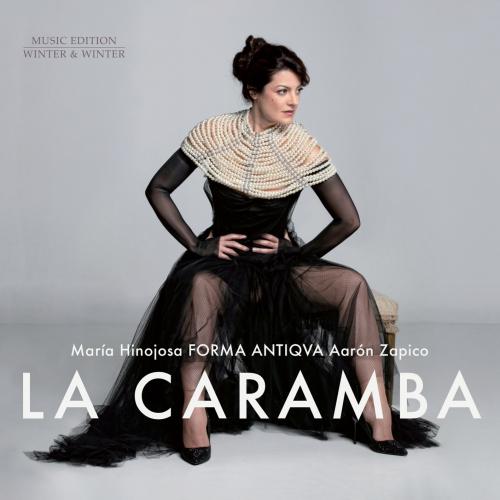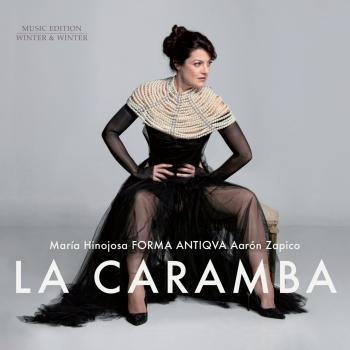
Album Info
Album Veröffentlichung:
2023
HRA-Veröffentlichung:
25.08.2023
Label: Winter & Winter
Genre: Classical
Subgenre: Vocal
Interpret: Forma Antiqva, María Hinojosa, Aarón Zapico
Komponist: Pablo Esteve (1730-1794), José Castel (1737-1807)
Das Album enthält Albumcover Booklet (PDF)
- José Castel (1737 - 1807): Sinfonía No. 3:
- 1 Castel: Sinfonía No. 3: Allegro 03:26
- Traditional: La Caramba:
- 2 Traditional: La Caramba: Allegro - Allegretto 01:57
- 3 Traditional: La Caramba: Coplas: Allegro 01:50
- 4 Traditional: La Caramba: Seguidillas: Andante Allegretto - Allegretto - Andantino 03:44
- Pablo Esteve (1730 - 1794): Los Duendecillos:
- 5 Esteve: Los Duendecillos: Allegro - Recitado: Andante 03:02
- 6 Esteve: Los Duendecillos: Andantino Gracioso 02:39
- 7 Esteve: Los Duendecillos: Coplas: Allegro 03:21
- 8 Esteve: Los Duendecillos: Seguidillas: Allegro Moderato - Allegretto 05:35
- José de Nebra (1702 - 1768): Obertura »Iphigenia en Tracia«:
- 9 Nebra: Obertura »Iphigenia en Tracia«: Allegro 03:48
- José Castel: El Arrendador del Sebo:
- 10 Castel: El Arrendador del Sebo: Andante Moderato - Más Andante 03:10
- 11 Castel: El Arrendador del Sebo: Coplas: Allegretto 03:04
- 12 Castel: El Arrendador del Sebo: Vivo 01:16
- 13 Castel: El Arrendador del Sebo: Seguidillas: Andantino 03:43
- Bernardo Álvarez Acero (1766 - 1821): Fandango:
- 14 Acero: Fandango 03:08
- Pablo Esteve: Los Mormuradores:
- 15 Esteve: Los Mormuradores: Andante Moderato y Cantable - Allegro - Como Prima - Allegro 03:19
- 16 Esteve: Los Mormuradores: Coplas: Allegretto Vivo - Andante - Fandango - Allegro 07:17
- 17 Esteve: Los Mormuradores: Seguidillas: Allegretto Moderato 05:46
Info zu La Caramba
Dieses Album ist María Antonia Vallejo Fernández (1751-1787), genannt »La Caramba«, einer berühmten spanischen Schauspielerin und Sängerin gewidmet. Wahrscheinlich stammt ihr Künstlername von ihrem Ausruf »Caramba, Caramba!« aus einer Tonadilla, einer kurzen, satirischen Musikkomödie, die im Spanien des 18. Jahrhunderts populär war. Caramba war auch der Name von María Antonias extravaganter Frisur, der zu einem Symbol für die damalige Frauenmode wurde. Die Rolle der María Antonia verkörpert María Hinojosa, ihre Musik erweckt Forma Antiqva zum lustvollen Leben.
DIE SÜNDEN VON MARÍA ANTONIA: Im Jahr 2019 fiel der Kopf von Kardinal Belluga [Motril, 1662 - Rom, 1743] herunter und rollte über den Boden. Der strenge, mit einer Schädeldecke versehene, skulpturale Kopf des Moralisten aus Motril konnte es nicht ertragen, dem Teatro Calderón de la Barca im Aeternum gegenüberzustehen, und so löste er sich vom Rest seines Körpers. Die fiebrige Phantasie von Luis Antonio de Belluga y Moncada betrachtete das Theater, die Musik, den Tanz und vor allem die Frauen als Werkzeuge des Teufels, um den Menschen die Sünde einzuimpfen. Er hielt dies auf Hunderten von Seiten und in Hirtenbriefen fest, in denen er mit verdächtigem Vergnügen die potenziell "schwer sündigen" Umstände aufzählte, die sich aus Tänzen ergaben, die zum Begrapschen anregen konnten, aus dem Schmuck und den Maßen der Frauenkleider und aus den Komödien und Sainten, die er Philipp V. aufforderte zu verbieten. Dennoch sind die göttlichen Absichten unergründlich. Sieben Jahre nach seinem Tod wurde in Motril das genaue Gegenbild seines Wesens geboren: María Antonia Vallejo Fernández, eine der beliebtesten und einflussreichsten Künstlerinnen des letzten Drittels des 18. Jahrhunderts.
Unter dem Namen "La Caramba" wurde sie zum Inbegriff der Sünde, die ihrem berühmten Landsmann so sehr vorschwebte: Star der „Sainete" und der „Tonadilla", Schauspielerin, Sängerin, Tänzerin, Unternehmerin, freie Frau und Mätresse mehrerer Liebhaber. Kurz gesagt, eine charismatische "Einflussnehmerin" des 18. Jahrhunderts, die in der Lage war, die Massen zu bewegen, die Mächtigen zu verärgern und die Modetrends in Sachen Kleidung und Schmuck zu diktieren - Modetrends, von denen der Kardinal sagte, dass sie "unendlich große Beleidigungen für Gott" darstellen. Dank der unermüdlichen Arbeit dieser Frau, die ihrer Zeit voraus war, können wir uns heute an zahllosen musikalischen Schätzen erfreuen, die vor Kühnheit, Frechheit und Witz nur so sprühen, verkörpert durch das Genre der „Tonadilla Escénica“, das noch nicht vollständig erforscht ist. ...
Maria Hinojosa, Sopran
Forma Antiqva
Aaron Zapico, Leitung
Forma Antiqva
is the personal and professional project of the 3 Zapico brothers: {Aarón}, {Daniel} and {Pablo}. Founded in 1999, in just a short time it has managed to secure a leading position in the sector of Baroque music in Spain thanks to their up-to-date, daring and accurate interpretations, their refined image and their presence on social networks.
Daniel, Pablo and Aarón try to ensure that every Forma Antiqva concert is a unique experience, whether playing as a trio, a chamber ensemble or as part of an orchestra.
Born in Asturias, Aarón Zapico has made a forceful arrival on the early music scene in Spain over recent years. The key to this success can be found in his elegant, resilient interpretations with their varied and nuanced dynamics, as highlighted by the specialized music critics. He is constantly present at the most important festivals and concert halls, where he can be found leading symphonic orchestras, specialised groups and his own ensemble Forma Antiqva.
His services are increasingly in demand as a guest conductor and he has had the pleasure of leading the Symphony Orchestra of Galicia, the Symphony Orchestra of the Principality of Asturias, the Philharmonic Orchestra of Malaga, the Orchestra of Extremadura, the Roquetas de Mar Baroque Orchestra and Choir, the Bilbao Choral Society, the Princess of Asturias Foundation Choir, the University of Santander Camerata Choir, the Youth Baroque Orchestra of Andalucía, the Santander Academy of Early Music, Acadèmia 1750, the Baroque Orchestra of Vélez Blanco and the Youth Orchestra of the Autonomous Community of Madrid.
In 1999 he founded the baroque music ensemble Forma Antiqva (resident in the Oviedo Auditorium), to which he dedicates most of his time and attention. In just a few years he has managed to secure the ensembles place in the top ranks of historical interpretation thanks to their performances at the most prestigious cycles, their international tours across Europe, Asia and Latin America, as well as their recordings which have been repeatedly praised by international critics.
An exclusive artist of the German record company Winter & Winter since 2009, his recordings as a solo artist and conductor have been nominated on 4 occasions for the International Classical Music Awards (2010, 2011, 2014 and 2017) and have obtained maximum recognition by European critics. His version of Antonio Vivaldis celebrated Four Seasons in 2012 had a genuine impact across Europe and was unanimously elected by the critics as an absolute reference point.
Committed to recovering Spanish music from the 17th and 18th centuries, he has directed numerous debuts in modern times of authors such as Blas de Laserna, José Lidón, Antonio Literes, Joaquín Lázaro and Jaime Casellas. In a like manner, his interest in contemporary music and new artistic manifestations has led him to work closely with Ernst Reijseger (1954), and to record his symphonic poem The Volcano Symphony written especially for Forma Antiqva, Fumio Yasuda (1953) or Uri Caine (1956), in the multidisciplinar project Poem of a cell, premiered at the Heineken Jazzaldia in San Sebastian.
With classical training and an outstanding advanced degree in piano from the Conservatory of Oviedo, he specialised in early music and harpsichord at the Royal Conservatory of The Hague, where he completed his soloist diploma with the unanimous praise of the board. At the same time, he also received advices from the most renowned worldwide specialists in historical interpretation.
He has collaborated for many years with some of the most outstanding symphonic orchestras and ensembles under the baton of Frans Brüggen, Emilio Moreno, Pablo González, Marzio Conti, Álvaro Albiach and Victor Pablo Pérez.
He has worked as harpsichord and chamber music professor at the conservatories of Murcia and Oviedo and as guest professor on the most important courses on early music. He has also given advanced courses and master classes in places such as Melbourne, Singapore, Gijón, Aracena, Burdeos, Costa Rica, Vélez Blanco, Granada and Albarracín.
In 2009, his restless, committed and entrepreneurial spirit led him to found and direct (until 2013) the Early Music Academy in Gijón. From 2011 to 2013 he also directed the Early Music Festival in the same city, as part of which he created the first International Competition of Early Music in Spain and different pioneering initiatives, such as concerts for disadvantaged people. He has also participated actively in the foundation of GEMA (Association of Spanish Groups of Early Music) and in the Platform for teachers, performers, composers and researchers of the Principality of Asturias.
Aarón Zapico has been finalist as Best Director in the GEMA Awards the years 2015, 2016 and 2017. He has been the recipient of the Asturian of the Month award from La Nueva España newspaper, the Group of the Year 2010 prize from the Television of the Principality of Asturias, the Asturian Music Award in 2012, the Serondaya Award for Cultural Innovation in 2012, and the FestClásica Award (Association of Spanish Festivals of Classical Music) in 2015. He has been member of the Jury for the Princess of Asturias Awards.
Booklet für La Caramba










